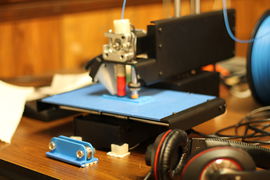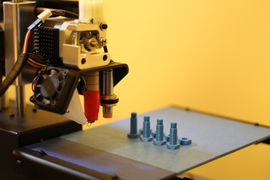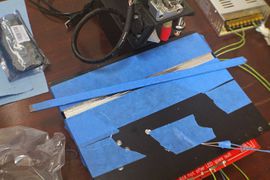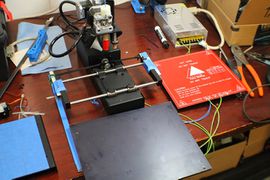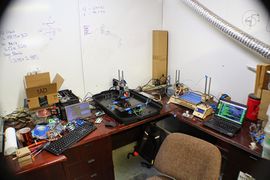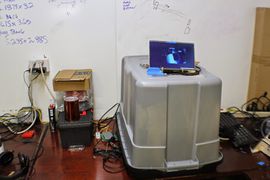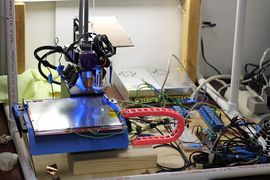Cerealbot
|
Creator: |
Contents
[hide]Map
Cerealbot/Financial - A list of links to every item I've purchased
Cerealbot/Archive - Cruft that still may be helpful
Overview
- Cerealbot Development
Regardless of an assortment of companies or model types, low cost FDM 3D printers operate on roughly the same level. Whereas I can incrementally fire off several dozen pages across multiple document types to our shop's laser printer from the comfort of my own home half an hour away, I can pretty much only 3D print while I'm present in the room to scrape each part off the build plate. This project, CerealBot, is my attempt at fixing a few of the issues that keep FDM printers out of practicality for a range of use-cases by making a low cost 3D printer serialized.
It is my hope that this project will bring about an affordable printer that can be placed in a school and maintained in a low-overhead, ad-hoc manner. The serialization will also allow for maximal student use from each printer, meaning that more investigative minds have access to this technology.
I'm sometimes busy with work or school, but I'll do my best to respond to all ideas and questions about the project:
Christopher Bero ctag on #makerslocal at freenode.net bigbero@gmail.com
Method
Background
While printing with an FDM machine, print adhesion becomes a big deal. If the surface of the print bed isn't "just so" then the part is liable to peel up or come unadhered, ruining it. Choosing a print surface is quite the art nowadays: Go online and try to find the correct print surface to use. You'll likely wind up with a dozen (stock/nothing, plain metal, blue tape, kapton tape, silicon, PEI, glass, etc) and instructions to "try each".
This makes a project like Cerealbot somewhat difficult. I need to find a way to have the part be firmly attached to the print plate while its being made, and then broken entirely free afterwards. If you have a printer and pretty good print adhesion, then think about it the next time you go to scrape off a part. I believe you'll be surprised how much dexterity is required, and then consider how difficult it will be for a robot to do the same task.
The Plan
I'm sidestepping the issue of print adhesion by not using a motor to break the print free. Instead, the current Cerealbot will cycle its hotbed up to ~60C a few times, and the process of heating up and cooling down the part repeatedly tends to totally remove its grasp on the build plate. Then the print head can push the part out of the way. BUT: if the part is printed underneath the print head's home location, then the print head will wind up drilling down into the part before trying to sweep it off the plate! To allow for use of the entire print surface, I've added a servo to the hot end which will swing down an arm to push parts off, this alleviates the issue of needing to lower the entire print head and risk crunching the printed part.
Build a Cerealbot
If you want to make your own serialized printer, start here.
You need:
- Borosilicate glass hotbed
- Servo mounted on the extruder carriage
- 12/24V fan aimed at hotbed
- Arduino to control fan and servo
- Octoprint server (w/ arduino attached)
Process:
- Script checks Octoprint for files that have not yet been attempted
- Script automatically starts the first new file it sees
- Printer prints part normally
- On completion, a script is called by octoprint
- The hotbed is "cycled" a few times
- Each cycle entails heating the glass plate and then cooling with the fan on
- This process shocks the printed object free of the glass
- The servo and print head scan the build plate and push the part away
Tasklist
- Validate shell scripts
- Right now I'm scaffolding with .sh files to test the algorithm which clears the print bed, I want a few continuous days of test prints.
- Fix this wiki
- Clear instructions, separate random notes from instructions.
- Migrate shell scripts to python
- Make project compatible with variety of printers
External Resources
Parts
Amazon is an OK outlet for GT2 gear/belt parts for the X-Y motion
Source for 2-3mm Hex Bolts like those used in the simple metal
MISC
Printrbot initial config guide
Protoparadigm plastic I'm interested in
Quick guide on authbind, which allows octoprint to bind port 80
http://hackaday.com/2013/10/23/3d-printering-a-call-for-an-open-source-automated-build-platform/
Glass is good for easy part removal
Other serial printers
Someone's building a Cerealbot! https://wiki.melbournemakerspace.org/projects/CerealBot
http://forums.trossenrobotics.com/showthread.php?6311-One-more-robotic-3D-printer-assembler

